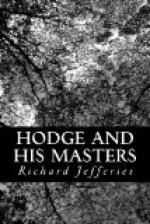He rode up the long drive, across the park, under the old elms, and alighted at the mansion before the dinner bell rang, much to his relief; for his host had more than one daughter, and Phillip liked to arrange his toilet to perfection before he joined their society. His twenty-five-guinea dressing-case, elaborately fitted up—too completely indeed, for he had no use for the razor—soon enabled him to trim and prepare for the dining-room. His five-guinea coat, elegant studs, spotless shirt and wristbands, valuable seal ring on one finger, patent leather boots, keyless watch, eyeglass, gold toothpick in one pocket, were all carefully selected, and in the best possible style. Mr. Phillip—he would have scorned the boyish ’master’—was a gentleman, from the perfumed locks above to the polished patent leather below. There was ton in his very air, in the ‘ah, ah,’ of his treble London tone of voice, the antithesis of the broad country bass. He had a firm belief in the fitness of things—in the unities, so to speak, of suit, action, and time.
When his team were struggling to force the ball by kick, or other permitted means, across the tented field, Phillip was arrayed in accurate football costume. When he stood on the close-mown lawn within the white-marked square of tennis and faced the net, his jacket was barred or striped with scarlet. Then there was the bicycle dress, the morning coat, the shooting jacket, and the dinner coat, not to mention the Ulster or Connaught overcoat, the dust coat, and minor items innumerable. Whether Phillip rolled in the mire at football, or bestrode a bicycle, or sat down to snow-white tablecloth and napkin, he conscientiously dressed the part. The very completeness of his prescribed studies—the exhaustive character of the curriculum-naturally induced a frame of mind not to be satisfied with anything short of absolute precision, and perhaps even apt to extend itself into dilettanteism.
Like geology, the science of agriculture is so vast, it embraces so wide a range, that one really hardly knows where it begins or ends. Phillip’s knowledge was universal. He understood all about astronomy, and had prepared an abstract of figures proving the connection of sun-spots, rainfall, and the price of wheat. Algebra was the easiest and at the same time the most accurate mode of conducting the intricate calculations arising out of the complicated question of food—of flesh formers and heat generators—that is to say, how much a sheep increased in weight by gnawing a turnip. Nothing could be more useful than botany-those who could not distinguish between a dicotyledon and a monocotyledon could certainly never rightly grasp the nature of a hedgerow. Bellis perennis and Sinapis arvensis were not to be confounded, and Triticum repens was a sure sign of a bad farmer. Chemistry proved that too small a quantity of silicate made John Barleycorn weak in the knee; ammonia, animal phosphates, nitrogen, and so on, were mere names to many ignorant folk. The various stages and the different developments of insect life were next to be considered.




